In an effort to help Camp supporters understand how we (Camp’s leadership) arrived at the current plan, below is a summary of the options we considered with a brief explanation of why we did not select these options. Please understand that these descriptions and reasons are not exhaustive. The LCA board and leadership determined that the proposed solution, which we are hoping you approve at this November’s annual meeting, is the best and most cost effective way to address Camp shoreline stabilization issues. If, after reading this, you have more questions please contact Executive Director, Chip May at (231) 889-4361 or chip@camp-arcadia.com.
In the 1980’s when the Army Corp built and expanded the Lake Arcadia channel rock walls one mile south of Camp Arcadia, our beach erosion increased significantly. The channel rock walls starved the shoreline of sand from the channel to the North Bluff. That can be seen from the overlook at the North Bluff. Today, Camp’s property protrudes out into the lake, protected still by its deteriorating wooden jetties, which the State of Michigan will not allow us to repair or replace, only remove them. Removing them, puts our buildings at risk. Therefore, we have decided to pursue a shoreline stabilization plan that meets the following criteria:
The LCA board used five criteria to judge the effectiveness of the systems we evaluated:
- Preservation of our buildings
- Beach access, even in high water
- Address the safety concerns with our current beach structures – jetties and seawalls
- Do no harm to our neighbors with our project
- A system that could receive a permit
It should be noted that in 2005 Camp created a Beach Erosion Control Committee with the same goals as the current effort, except for the consideration of how likely the system could be permitted. The current effort to find a shoreline stabilization solution is not a departure from past efforts but a continuation of the same effort with the same goals.
Over the years, we have investigated the multiple options shown below, and we want to take a moment to discuss them with you.
Beach nourishment means adding additional sand to our beach. This can be done by taking sand that was dredged from Lake Michigan and pumping it to our beach. A few years ago this took place when the Lake Arcadia channel was dredged and the spoils were pumped to the Arcadia Township public beach at the southern end of Camp’s property. The Camp paid $10,000 for the additional distance that sand had to be pumped, since it has been usually pumped just few hundred feet north of the channel. Since then, the Arcadia Township did not change the permit, which dictates where the sand is to be placed, to allow the sand to be placed at the public beach or Camp’s beach. The Township is willing to change the permit, and they plan to do so in the future.
Changing the permit does not mean that we can get the dredged sand. We still would need to work with the dredging company and pay for any extra cost to get the sand pumped further north to Camp’s beach. Currently the company that does the dredging is not interested in working with us to move the sand further north. They are mostly concerned with getting the channel open so boats can go in and out of the channel.
Let’s say we can get the dredged sand from the channel, would this solve our problem? No, more sand is good, but the 5,000 to 10,000 cubic yards of dredged sand would not protect our buildings and it would not necessarily provide a significant beach for the whole summer. Depending on the lake levels and wave energy throughout the summer the sand could be gone overnight if a big storm came through the area. That being said, please know that we are continuing to try and get the sand from the channel because it is a relatively cheap source of sand and regardless of the beach erosion system we have more sand is always better.
Can you dredge sand from other parts of Lake Michigan?
No, the State of Michigan will not allow sand from offshore to be moved or pumped to a beach.
Instead of using dredged sand why don’t you just truck in sand? Trucking in sand is a much more costly process. The sand costs more and the process to get it to our beach is more involved. We would need to build a road to the beach, either at the northern or southern end of our property, or both. Then we would need to remove most or all of the jetties so you could access the beach with earth moving equipment to deposit the sand and spread it up and down the beach. To get significant amount of sand on Camp’s beach would require hundreds of truckloads of sand, which would take weeks. To get 10,000 cubic yards of fill sand we would need 1,000 truckloads (assuming a 10 cubic yard truck). The cost is around $75 – $125 per truckload, so the cost for the sand would be $75,000 – $125,000 for just the sand, not including the cost of spreading it around. There is of course the expense of building the roads, and the landscaping to repair damage from the equipment. In the end, the sand could be gone in a day if a big storm occurred. This process and expense would need to be repeated bi-annually. This option also does very little to protect our buildings in case of high water.
The idea would be to relocate the Inn, Assembly, Wigwam, and Craft Shop to east of Forest View Drive (where the entrance sign to Camp is located), thus, far enough back so we could remove our current beach erosion system (wooden jetties, concete and steel seawalls), and let the beach return to it’s natural state, providing a sandy beach. The estimated cost of moving the buildings is approximately $300,000. That is just the cost for building relocation. That does not take into consideration removing the wooden jetties and seawalls, the relocation of utilities, the relocation of roads, and moving the Chapel on the Beach and tennis courts. The estimated cost for everything is between $1 – $2 million. The reasons for not selecting this option include:
- If we remove the current system we would have increased erosion. We don’t know how fast the beach will erode. We have had most of our beach protected by wood, steel and cement structures for decades, and as a result we have not suffered the full effects of beach erosion. Due to the channel into Lake Arcadia stopping sand from coming to our beach, we know that we are starved of sand. The fear is that we could spend millions moving buildings, and have the shoreline quickly recede, thus threatening the relocated buildings.
- Moving the buildings back far enough to make the investment worthwhile would put the center of camp and its buildings east of Forest View Drive to assure long-term protection. That would drastically change the Camp experience. We would not really be on the Lake like we are now, and we would lose many of the trees surrounding and behind Camp.
- We have almost 100 year old buildings in some cases. Moving them is something we would need to do very, very carefully. We have serious reservations about moving such historic structures, and would be very nervous about the unforeseen buildings’ infrastructure issues we could encounter or create.
Submerged Groins
One example of submerged groins was proposed 10 years ago. This is a system of large textile tubes filled with concrete or sand, sticking out into the lake. The tubes are connected by a concrete revetment parallel to the shore. The tubes start above the lake levels and then go into the water until they are covered with water. The idea is that they slow down waves like speed bumps and drop off sand as they slow down and build a beach. In the 1980’s some of these were put in on the Lake Michigan shoreline. The cost was estimated around $1 – 2 million. Reasons for not selecting this option include:
- The State of Michigan and Army Corps of Engineers has made it very clear they will not permit such structures because they go out into the Lake. This means they are on State land and the State is responsible for structures on their property.
- Submerged groins could steal sand from neighboring properties since, like the channel into Lake Arcadia, submerged groins would be stopping sand traveling up and down the shoreline. This claim is disputed by submerged groin supporters.
- These systems were put in high water levels in the late 1980’s and then the water went down. So, it looked like they were successful, but compared to control sites there was very little sand accretion. In addition, the integrity of the systems have not held up over time. Inspection of systems installed in the 1980’s shows the tubes are breaking off and sinking into the lake.
- Submerged groins work the best in moderate lake levels, and they are not especially effective in high water – meaning that they do not accrete as much sand in high water periods and they are not effective protection against high water and storm activity.
Some have suggested that we just put the rock revetment north of the Inn observation deck and keep the area to the south “natural”. This would mean removing the structures that are south of the Inn observation deck and letting the sand flow back into the lake. The goal would be to provide a beach to the south with the removal of the structures. Reasons for not selecting this option include:
- The area to the south, with the removal of the structures, could face severe erosion putting at jeopardy the Inn, the proposed Inn addition, and the Chapel on the Beach. We could choose to keep the wooden jetties and seawalls to the south, but they are falling apart and are a safety hazard. And, as stated above, the State of Michigan will not allow us to repair, upgrade, or replace the current jetties.
- By keeping the area to the south as it is or removing the wooden jetties we do not provide beach access as predictably as we would do with a pocket beach. Also a pocket beach offers an easier access to the beach than the 10 – 15 foot descent we currently have to the beach from the turn around steps. A pocket beach allows more people to have access to the beach.
Do Nothing
This option is based on the following assumptions. Below each assumption are reasons why Camp’s leadership has not selected this option:
- Our buildings, even at high water, are not in jeopardy. The water comes up and the water goes down and Camp has always been okay.
- Throughout Camp’s history, in a response to high lake levels and beach erosion, and with the intention of protecting our buildings, Camp leadership has chosen to install three overlapping seawalls, concrete piers, and wooden jetties. Recent high water and the inability to repair, enhance, or replace our jetties has caused us to look for more solutions to last for generations.
- No one knows what the lake levels will do. We know lake levels are cyclical and they will eventually go down, but we don’t know how high they will go before they go down. Scientists agree that severe storms and extreme climate changes are increasing across the globe. So there is a chance that we could have more intense and frequent storms which challenge our buildings. Thus, doing nothing is a risk the LCA board is unwilling to take.
- We have been unable to find structures as close to Lake Michigan as our Inn, Assembly, and Wigwam that do not have a rock revetment or major seawall.
- The process of determining where a revetment would go is complex, but we know that “once the beach is wet” it becomes more difficult to permit putting something in the area covered by water. So, if we wait till the water comes up higher, even possibly passing the high water mark of 1986, the closer the rocks will be to our buildings and walkways. By waiting we lose land, making our revetment less attractive and because it is closer to the buildings, possibly putting our buildings at risk.
- If we wait until the lake levels are really high and the buildings are at risk, the LCA will have backed itself into a corner. The price of the project greatly increases because every other lakeshore property owner wants work done. It will take at least six months to get a state permit. And such an expense will require LCA membership approval, which would also require 6-12 months.
- We do not have a natural beach. What beach we have is the result of buried and exposed seawalls and deteriorating jetties. Our beach is affected by the channel rock walls, the cottage colony’s rock revetment, and of course our own structures. While it would be great to find a way to get a natural beach, we have not found one. We have to live in the reality of our situation.
- Camp’s guests have not had reliable access to the beach to the north of the Inn observation deck for decades. Most years there is no beach there, even in low water periods the beach there is very small, rocky, and difficult to access. Wooden seawalls, cement and steel seawalls, broken down cement piers, parts of the old tennis courts concrete and steel jetties litter this area of the beach.
- Putting a rock revetment in this area would minimally affect guest use since it is so rarely used. Rocks would be a better protection and in low water where there was some sand in front of the rocks, provide a better walking experience. We could put removable wooden steps down to the beach in low water times.
The current system is okay and it is not a safety hazard.
- We have been blessed to not have many accidents on our beach, but the system is clearly falling apart, and it does pose an increasing safety hazard to our guests. Since the State of Michigan will not allow us to repair or replace any of our structures that stick out into the lake, we have chosen to remove them.
The rock revetment will prevent a beach from forming in front of it and we will have to look at rocks instead of the sand and dune grass we have now.
- The rock revetment at Weiherman Beach was covered by sand during low water periods providing more beach area. The rock revetment at Camp’s northern end was put in when the Cottage Colony put in their revetment and in low water periods it has been covered with sand and dune grass. Also, plants, grass, and trees grow on revetments. A rock revetment does not mean that we won’t have sand in front of it, and we intend to fill in the revetment at the top with sand and plant dune grass. Part of the plan is to have the area east of our new revetment landscaped with walkways, plantings, and lighting.
If you have any questions please contact Executive Director, Chip May at (231) 889-4361 or chip@camp-arcadia.com.

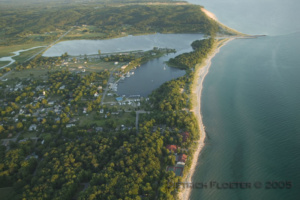
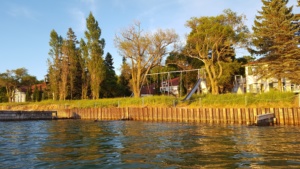
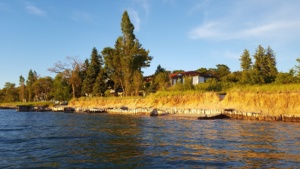
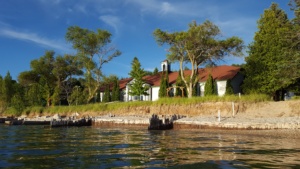


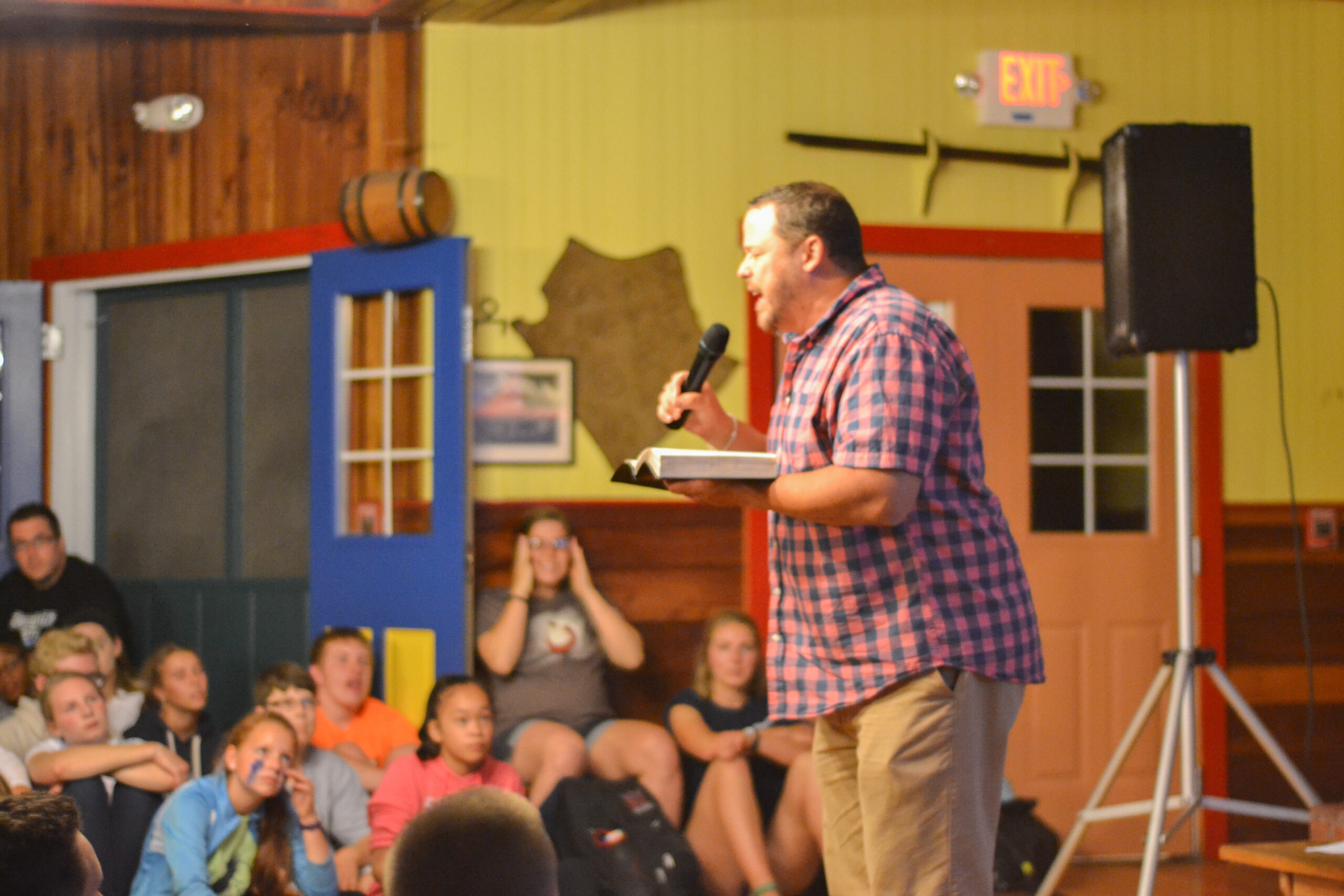
4 Responses
Well done! I think we are very fortune someone has not been injured on the jetties . They are very dangerous and an eyesore. For me the rocks have their own kind of beauty and could not be more natural. My only concern is that the pocket beach is large enough to accomadate lots of beach goers and that it is sustainable. N
Thank you for providing such a comprehensive detailed analysis
of the beach situation.
As a fairly new LCA life time member
who visits camp 1-2 times per year,
it’s challenging for me to understand
all that is involved.
This has been most helpful, I’m
always impressed with the due diligence
when camp has a project at hand.
Great time and effort is given to
examine all options.
We will support the LCA board
recommendations.
Most Respectfully,
Liz Turner
Chip, Thank you for your very detailed explanation of the decision-making process and for addressing many of the alternate suggestions. One more question – were you able to talk with ________ (former Corps of Engineers Layman) about whether the COE decreased out-flow from Superior and increased out-flow from Erie in 1987 in response to highest-on-record lake levels of Mich., Huron, and Erie in 1986 and January 1987 causing much damage to lakefront properties?